Intel Core i7 4960X (Ivy Bridge E) Review
by Anand Lal Shimpi on September 3, 2013 4:10 AM EST- Posted in
- CPUs
- Intel
- Ivy Bridge
- Ivy Bridge-E
Memory Performance
Seeing as how the huge L3 cache and quad-channel memory interface are big parts of what makes Ivy Bridge E unique, I thought it might make sense to look at memory latency and bandwidth. We'll start with memory latency, compared to Ivy Bridge, Haswell and Haswell + Crystalwell.
The larger L3 cache buys IVB-E lower latency accesses for a wider range of addresses, but once you exceed the 15MB L3 cache space we see latency about on par with everything else. Only Haswell + Crystalwell manages to hold out for longer. Unfortunately that's not really a part desktop enthusiasts can buy so it's mostly an academic comparison.
The bandwidth story is an interesting one. Sandra maxes out bandwidth by driving all cores at the same time, so you get some uplift here by there simply being more cores under IVB-E's hood. But even if you divide out the number of cores, you get per core cache bandwidth figures that are extremely high (at least outside of L1). The L3 cache in particular is quite bandwidth happy.
Going outside of the L3 cache, we also see a doubling of memory bandwidth - which is expected given the doubling of memory interface width. In reality the peak memory bandwidth advantage would be even larger as IVB-E officially supports DDR3-1866 (if you only populate 1 DIMM per channel, otherwise either 1333 or 1600 is officially supported).
General Performance
I don't know that I've ever seen an Intel slide before that called out a performance degradation, but there's a first time for everything:
The problem with IVB-E vs. Haswell is that the extra large L3 cache and quad-channel memory interface are generally only useful in heavily threaded applications, which of course benefit from its 6-core configuration. In those tests that aren't heavily threaded however, IVB-E typically sees a single threaded performance deficit compared to Haswell. Given that the 4960X and Haswell based Core i7-4770K run at very similar frequencies, it's not surprising to see IVB-E take a backseat to Haswell in in "everyday computing" tasks. Intel's slide above claims about a 18% reduction in "everyday computing" performance compared to the 4770K, but in practice I found the gap to be much narrower.
Although not the best indication of overall system performance, the SYSMark 2012 suite does give us a good idea of lighter workloads than we're used to testing.
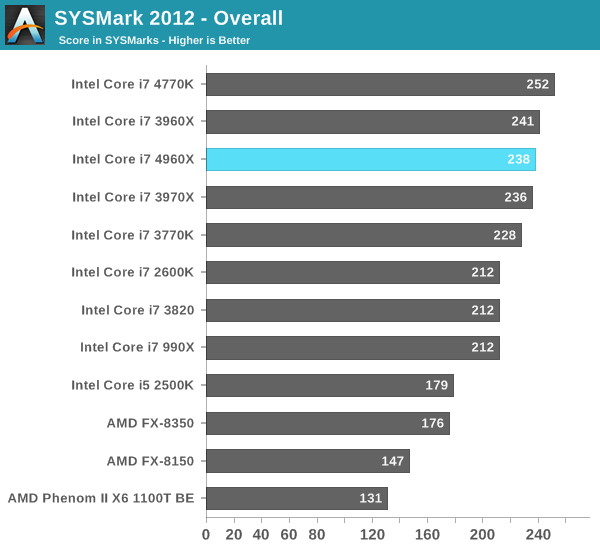
There's pretty much no advantage to the 4960X over the 3970X here. Remember Ivy Bridge's architectural improvements were very limited on the CPU side. As clock speeds didn't really go up between the 3970X and 4960X, the performance parity here isn't surprising. Haswell manages a ~6% performance advantage over the 4960X at an obviously lower power and price point.
Although I retired SYSMark 2007 a while ago, I do have much older performance data here which lets us compare the 4960X back as far as the early Pentium 4 based Extreme Edition parts:
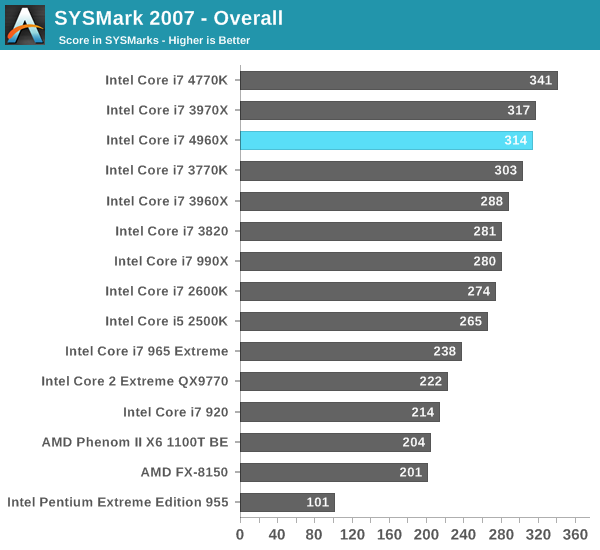
The Haswell advantage grows a bit here to around 8%, but the 4960X remains in the top three performers here. It's very clear that for most users, there are far more cost effective ways of getting great performance than IVB-E.
Our final lightly threaded test is Mozilla's Kraken JavaScript benchmark. This test includes some forward looking js code designed to showcase performance of future rich web applications on today's software and hardware. We run the test under IE10:
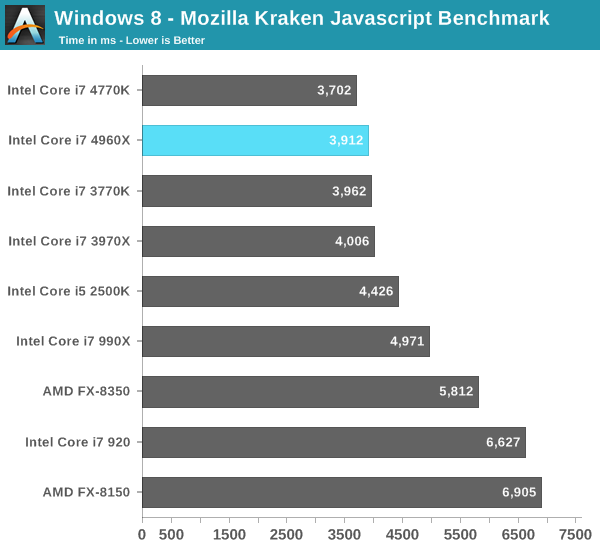
Ivy Bridge always had good single threaded performance, but once again these lightly threaded use cases are better served by an architecture with higher IPC. The Haswell advantage isn't huge, but it's a lower power/more cost effective way to get the best performance here.
If you are still on LGA-1366, you'll note that the performance gains here are good, but not earth shattering. Comparing to Intel's first 6-core platform, the 4960X manages a 27% increase in performance over the Core i7-990X. That's a healthy gain, but it's still small enough where there's no immediate need to upgrade.


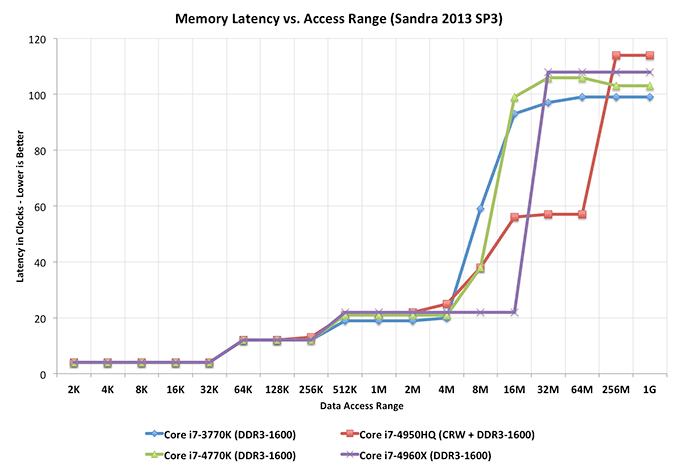
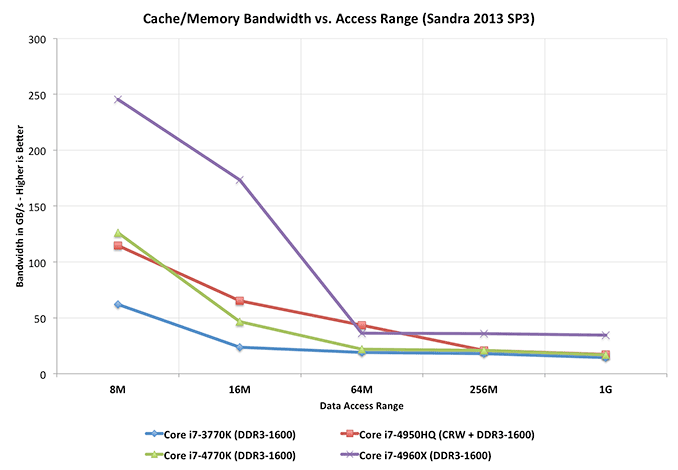
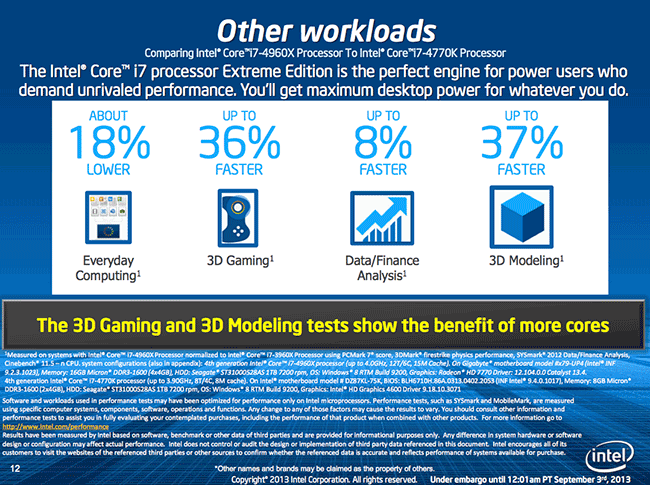








120 Comments
View All Comments
Oscarcharliezulu - Friday, September 6, 2013 - link
This reminds me, of years ago when I had access to the first DEC Alpha with its super fast clock speed and fast IPC, a IBM AIX RS6000, a HP9000 PA-RISC and a multi-socket Sparc. The alpha was the fastest by a long way versus multi core even on our SAP systems. I still use this as a rule of thumb that for most tasks a faster clocked processor is better most of the time, except for very specific situations - and in general you will know what they are. I'm battling with what to do with my next upgrade, I really wanted a top end ivy-e but it really doesn't seem worth it compared to a 4770, even with my need to run big VM's. he'll its not enough faster than my i2500s ivy imac to be worth it.DPOverLord - Tuesday, September 10, 2013 - link
very interesting review coming from an i7-930 O/C to 4.3GHZ makes you debate if it makes sense to upgrade to the 4930K and a RIVE.For those considering there is also another benchmark review of the 3930K vs I7-930 on 2, 3, & 4 way TITAN SLI GK110 Scaling at 7680 x 1440 and 7680 x 1600. Worth a look.
DPOverLord - Tuesday, September 10, 2013 - link
very interesting review coming from an i7-930 O/C to 4.3GHZ makes you debate if it makes sense to upgrade to the 4930K and a RIVE.overclock.net/t/1415441/7680x1440-benchmarks-plus-2-3-4-way-sli-gk110-scaling/0_100
For those considering there is also another benchmark review of the 3930K vs I7-930 on 2, 3, & 4 way TITAN SLI GK110 Scaling at 7680 x 1440 and 7680 x 1600. Worth a look.
Remarius - Wednesday, September 11, 2013 - link
Really useful - I missed that thread somehow.Fierce Guppy - Saturday, September 14, 2013 - link
Should nVidia's shadowplay turn out to be rubbish then I could use that CPU for encoding recorded gameplay, otherwise there's no benefit in having a 4960X over a 4770K. It won't improve my gaming experience any. Two GTX 780s will do that.scorpyclone - Tuesday, September 24, 2013 - link
This is a great article for informing us about the latest and greatest architecture and chips, anyway I too have stuck with my powerhouse system since 2006, mine is the Q9550 and P35 mobo, DDR2 second generation SSD and so forth!It has been rock solid and frankly I don't think I remember the last time it crashed, come to think of it it has never crashed! (...and I am able to have all my progs running plus 30 plus instances of chrome, yeah I should do something about that!)
So there you have it, now i m looking at the LGA 2011 with X79 and maybe (If i can convince myself of the benefits of having a six core system) an i7 4920 or40, ...but will probably go with their 4 core 10 or 12 meg cache cpus...the difference in having 2 more cores is 200 bux! I don't have any problem spending 3 bills on a nice CPU, but when it comes to 2 more bills just to get 2 more cores, I really cant convince myself of that, since i can think of so many other ways to spend those two bills with more return so to speak!
So yeah building a powerhouse of a system that costs a little more but is rock solid and still faster than 90 percent of what is out there is worth it for me, and I am sure others will say the same!
Or maybe I can just get the better P45 chipset, and stick with this system for another two to three years!
Laphaswiff - Monday, December 9, 2013 - link
δοκοῦσι δέ μοι Λακεδαιμόνιοι μάλα δεινῶν ἔργον ἀνθρώπων ποιεῖν. νῦν γάρ φασιν ἐκεῖνοι δεῖν Ἠλείους μὲν τῆς Τριφυλίας τινὰ κομίσασθαι, Φλειασίους δὲ τὸ Τρικάρανον, ἄλλους δέ τινας τῶν Ἀρκάδων τὴν αὑτῶν, καὶ τὸν Ὠρωπὸν ἡμᾶς, οὐχ ἵν' ἑκάστους ἡμῶν ἴδωσιν ἔχοντας τὰ αὑτῶν, οὐδ' ὀλίγου δεῖ· (17) ὀψὲ γὰρ ἂν φιλάνθρωποι γεγονότες εἶεν· ἀλλ' ἵνα πᾶσι δοκῶσι συμπράττειν, ὅπως ἕκαστοι κομίσωνται ταῦθ', ἅ φασιν αὑτῶν εἶναι, ἐπειδὰν δ' ἴωσ' ἐπὶ Μεσσήνην αὐτοί, συστρατεύωνται πάντες αὐτοῖς οὗτοι καὶ βοηθῶσι προθύμως, ἢ δοκῶσ' ἀδικεῖν, περὶ ὧν ἔφασαν ἕκαστοι σφῶν αὐτῶν εἶναι συμψήφους λαβόντες ἐκείνους, μὴ τὴν ὁμοίαν αὐτοῖς χάριν ἀποδιδόντες.SeanFL - Wednesday, January 15, 2014 - link
I edit video from time to time and am currently using an i7-2600k system built in May of 2011. I've been looking at the 6 core i7-3930k, but not sure if it provides enough of an increase to build a new system. Are we closer to an 8 core solution coming out under $1000 in 2014? What's on the way?SeanFL - Wednesday, January 15, 2014 - link
typo, meant looking at the i7-4930k. Still wondering, is 8 core under $1k on the way this year?MordeaniisChaos - Thursday, April 17, 2014 - link
You guys should really, really include ArmA as a benchmark for CPU gaming performance, as it sees pretty much constant improvements as the CPU gets more potent. I do not understand why more sites don't use A3 for CPU benchmarking when they touch on gaming performance.